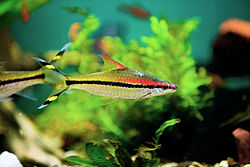Denison barb
| Sahyadria denisonii | |
|---|---|

| |
| Scientific classification | |
| Kingdom: | |
| Phylum: | |
| Class: | |
| Order: | |
| Family: | |
| Genus: | |
| Species: | S. denisonii
|
| Binomial name | |
| Sahyadria denisonii (F. Day, 1865)
| |
| Synonyms | |
| |

Sahyadria denisonii (Denison barb, Miss Kerala, red-line torpedo barb, or roseline shark) is a species of cyprinid fish endemic to the fast-flowing hill streams and rivers of the Western Ghats in India.[2][3] It is commonly seen in the aquarium trade.[4]
Physical characteristics
The fish is characterized by a torpedo-shaped body with silver scales, a red line running from their snout, through the eye, back towards the middle of the body; and below the red line, a black line that runs the length of the fish to the tail. As they mature, a distinctive green/blue marking on top of the head develops. This species reputedly reaches a length of 15 centimetres (5.9 in) TL,[2] but typically will only reach 9–11 centimetres (3.5–4.3 in).[4] They are active schooling fishes.[4]
The species was described by Francis Day and named after Sir William Denison.[5]
Habitat and threats
Denison barb is endemic to the Achenkovil,Pamba and Chaliyar rivers. Specifically, they are found in four locations — Cheenkannipuzha (a major tributary of Velapattanam River), the Achankovil river, the Chaliyar river and near Mundakayam town.[6] The species has an estimated range of 8,805 km2 (3,400 sq mi). S. denisonii is a benthopelagic species that is gregarious and shoals are known to occur in rocky pools with thick vegetation along their banks. They thrive in a subtropical climate in water with a 6.8–7.8 pH, a water hardness of 5–25 dGH and a temperature range of 65 to 79 °F (18 to 26 °C).
As reported by Practical Fishkeeping in January 2009, new research by team of scientists from India suggests that the species is being over-exploited for the aquarium trade, potentially placing it at risk of extinction.[7] In spite of being listed as Endangered by local assessment reports [8] the fish had been promoted as an 'Export item' by several government agencies. The population structure, age, growth, mortality and harvest intensity in the Valapattanam River was studied and suggests that the species is being over-exploited.[9]
The fish was most likely collected and exported out of India in 1996. In 1997, it won the third prize at 'Aquarama 1997' (world exhibition on Ornamental fish) under the 'New Species Category'.[10] By 2007-08 it constituted about 60- 65% of the total live ornamental fish exported from India which was worth US$1.54 million. Though the Government of Kerala banned the fishing and export of the endangered barb, it is yet to be listed under the National Wildlife Protection Act.
In the aquarium

This fish is a relatively new addition to the fish keeping hobby. The Denison's barb is a schooling fish that is usually kept in groups. It tends to be peaceful but some have been known to be slightly aggressive around food, especially if kept in less space than they require. They eat bloodworms, shrimp, meat, fish flake and some vegetation. A similar fish, Sahyadria chalakkudiensis is sometimes confused with this fish, but it is a larger, less colourful and a more aggressive species.
Breeding
Over the years many efforts have been made to breed this rapidly depleting species in captivity, initially with limited success. In 2009, success came from the work carried out at the Fisheries College, Kerala by Dr.T.V Anna Mercy. Equally if not more important breeding efforts have been carried out by Chester Zoo and two amateur fish-lovers from Chennai (India), Venkatesh and Murali.[6] These efforts would pave the way for standardizing the process and would be a major boost to conservation and the ornamental fish trade in India. Large numbers are now being bred in captivity at commercial facilities.[4][11]
See also
References
- ^ Ali, A., Raghavan, R. & Dahanukar, N. 2011. Puntius denisonii. In: IUCN 2013. IUCN Red List of Threatened Species. Version 2013.2. <www.iucnredlist.org>. Downloaded on 28 November 2013.
- ^ a b Froese, Rainer; Pauly, Daniel (eds.). "Puntius denisonii". FishBase. October 2013 version.
- ^ Raghavan, R., Philip, S., Ali, A. & Dahanukar, N. (2013): Sahyadria, a new genus of barbs (Teleostei: Cyprinidae) from Western Ghats of India. Journal of Threatened Taxa, 5 (15): 4932-4938.
- ^ a b c d Seriously Fish: Puntius denisonii. Retrieved 26 June 2014.
- ^ Day, F. (1865). "On the fishes of Cochin, on the Malabar Coast of India. Part II. Anacanthini". Proceedings of the Zoological Society of London: 286–318.
- ^ a b Mathew, Dennis Marcus. ‘Miss Kerala’ gets a protective shield, The Hindu(February 01,2010) [1]
- ^ Practical Fishkeeping(January 11, 2009), Kerala government bans fishing for this species.[2]
- ^ Molur, S. and Walker, S., Report of the workshop on ‘Conservation Assessment and Management Plan for Fresh Water Fishes of India’, Zoo Outreach Organization and NBFGR, Lucknow, 1998,p. 156.
- ^ SAJAN,S., T.V. ANNA MERCY AND V. MALIKA,Asian Fisheries Science 28 (2015):130-142, http://www.asianfisheriessociety.org/publication/abstract.php?id=1082
- ^ Raghavan, R. et al., Aquat. Conserv: March Freshwater Res., 2009, 19, 67–74.
- ^ T. V. Anna Mercy, S. Sajan, V. Malika (2015) Captive breeding and developmental biology of Sahyadria denisonii (Day 1865) (Cyprinidae), an endangered fish of the Western Ghats, India. Indian Journal of Fisheries 62(2).
- Clarke, Matt. "The Red lined torpedo, Puntius denisonii (with details on an imposter species P. chalakudiensis)". Practical Fishkeeping. Retrieved April 19, 2004.
External links
- Puntius denisonii breeding - Photos of Puntius denisonii’s epic journey from egg to hatchling, from www.fishesninverts.com
- Photos at Fishbase
- Madan Subramanian at Bangalore, India
- Puntius denisonii fish profile and detailed photos on fishforums.com
- Threatened freshwater fish fall through net of mismanaged aquarium pet trade (IUCN) [3]

